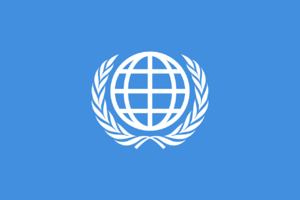Council of Nations
This article is incomplete because it is pending further input from participants, or it is a work-in-progress by one author. Please comment on this article's talk page to share your input, comments and questions. Note: To contribute to this article, you may need to seek help from the author(s) of this page. |
 | |
| Abbreviation | CoN |
|---|---|
| Motto | "It's Your World" |
| Formation | 12 October 1944 |
| Founders | Caropsyne Pontanore Loslakia Latagon Forthampton |
| Type | Intergovernmental Organization |
| Headquarters | Fornænda |
Membership | 3 member states |
Official languages | Standard Caropsyne, Loslakian, Anglish |
President | X |
Secretary | X |
Main organ | General Assembly Security Council |
| Website | con.lib |
The Council of Nations is Paradisia's intergovernmental organization tasked to promote international cooperation and to create and maintain international order. The Council has three core objectives: peacekeeping and security, human rights, and economic development and humanitarian assistance.
Structure
There are three main representative bodies within the Council Of Nations:
- The General Assembly
- The Security Council
- The President of The Council of Nations
All nations have a seat in the General Assembly, and cannot ever be denied that right, however, a nation may pull out if they wish to do so. Every nation has an equal say in the assembly when it comes to voting. The General Assembly can form, debate and vote upon resolutions of almost any kind, with regards to almost any topic. If two member states state their support for the motion, the resolution is taken to debate and eventually voted upon. If passed, the resolution will be put into force into all member nations regardless of their vote, most of which are non-binding.
Resolutions concerning peace and security are sent from the General Assembly to the Security Council for their consideration and approval before its put into force. All resolutions passed by the Security Council are binding upon all nations. This council is made up of 11 nations, five permanent and six rotating.
The final body of the Council Of Nations is that of the President Of The Council. This carries some of the most important roles in the whole council. The President is effectively both the Leader of the organization, as well as the Speaker of the General Assembly. He, or she, is responsible for both ensuring that all resolutions follow the correct procedure at the correct pace, as well as ensure that order is kept within all chambers. The President also must attempt to lead the Council Of Nations in their ideal direction by putting forward resolutions to shape the council, as well as the world. In fact, the president could even be seen as the most powerful person on the planet. As well as all this, the President represents the council as a whole, especially with regards to the press. In other words, the president is responsible for conducting interviews, statements, and press releases with the world media. The President is responsible for leading a team of staff that is above all nations that are tasked with the investigation of various nations to ensure that they are meeting the binding resolutions.
Specialized Organizations
TBD